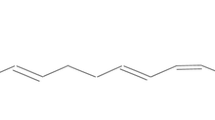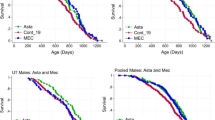Abstract
The toxicity of 2,3,7,8-tetrachlorodibenzo-p-dioxin [TCDD] and its congeners involves binding to a specific TCDD [Ah] receptor, interaction of this complex with chromatin, and the ultimate production of pleiotropic responses. The mechanism whereby these effects are produced following interaction of TCDD with the receptor complex is not known. Oxidative stress following the production of reactive oxygen species (ROS) may play an important role in the toxic manifestations of TCDD. Thus, the dose and time-dependent effects of TCDD on the production of superoxide anion by peritoneal lavage cells (primarily macrophages) from rats were examined. A maximum increase in superoxide anion production occurred on day 1 after treatment in rats with 50 and 125 μg TCDD/kg. At 6 h after a single dose of 125 μg TCDD/kg, a 2.4-fold increase in superoxide anion production was observed in peritoneal lavage cells from rats. A single dose of 5 μg TCDD/kg had no effect on superoxide anion production by peritoneal lavage cells. A significant increase in DNA single strand breaks within peritoneal lavage cells occurred at 12 h after the oral administration of 50 μg TCDD/kg, and a maximum increase in DNA single strand breaks was observed on days 3–5 after treatment. No DNA damage was detected at a dose of 5 μg TCDD/kg. No difference was observed with respect to dose and time in the composition of the peritoneal lavage cells. The results clearly indicate that the oral administration of TCDD activates peritoneal lavage cells in rats, and that the activation precedes the formation of DNA single strand breaks. The results support the hypothesis that the tissue damage by TCDD may be due, at least in part, to the formation of reactive oxygen species, and macrophages may serve as one source of reactive oxygen species in response to TCDD.
Similar content being viewed by others
References
Al-Bayati ZAF, Stohs SJ (1987) The role of iron in 2,3,7,8-tetrachlorodibenzo-p-dioxin (TCDD)-induced lipid peroxidation in rat liver microsomes. Toxicol Lett 38:115–121
Alsharif NZ, Grandjean CJ, Murray WJ, Stohs SJ (1990) 2,3,7,8-Tetrachlorodibenzo-p-dioxin (TCDD)-induced decrease in the fluidity of rat liver membranes. Xenobiotica 20:979–988
Ames BN (1989) Endogenous oxidative DNA damage, aging and cancer. Free Rad Res Commun 7:121–128
Bagchi M, Prasad MR, Engelman RM, Das DK (1989) Effects of free radicals on the fluidity of myocardial membranes. Free Rad Res Comms 7:375–380
Biaglow JE, Varnes ME, Epp ER, Clark EP, Tutle SW, Held KD (1989) Role of glutathione and other thiols in response to radiation and drugs. Drug Metab Rev 20:1–12
Bombick DW, Madhukar BV, Brewster DW, Matsumura F (1985) TCDD (2,3,7,8-tetrachlorodibenzo-p-dioxin) causes increase in protein kinases particularly protein kinase C in the hepatic plasma membrane of the rat and the guinea pig. Biochem Biophys Res Commun 127:296–302
Christiansen NO, Larsen CS, Esmann V (1988) A study on the role of protein kinase C and intracellular calcium in the activation of superoxide generation. Biochem Biophys Acta 971:317–324
Cross CE, Halliwell B, Borish ET, Pryor WA, Ames BN, Saul RL, McCord JM, Harman D (1987) Oxygen radicals and human disease. Ann Intern Med 107:526–545
Dianzani MU (1987) The role of free radicals in liver damage. Proced Nutr Soc 46:43–52
Elferink JGR (1984) Measurement of the metabolic burst in human neutrophils: A comparison between cytochrome C and NBT reduction. Res Comms Chem Path Pharmacol 43:339–342
Frenkel K (1989) Oxidation of DNA bases by tumor promoter activated processes. Environ Hlth Persp 81:45–54
Gopalakrishna R, Anderson WB (1989) Ca2+- and phospholipid-independent activation of protein kinase C by selective oxidative modification of the regulatory domain. Proc Natl Acad Sci USA 86:6758–6762
Hassan MQ, Mohammadpour H, Hermansky S, Murray WJ, Stohs SJ (1987a) Comparative effects of BHA and ascorbic acid on the toxicity of 2,3,7,8-tetrachlorodibenzo-p-dioxin (TCDD) in rats. Gen Pharmacol 18:547–550
Hassan M, Stohs SJ, Murray WJ (1987b) Effects of vitamin E and A on TCDD-induced lipid peroxidation and other biochemical changes. Arch Environ Contam Toxicol 14:437–442
Kensler TW, Bush DM, Kozumbo WJ (1983) Inhibition of tumor promotion by a biomimetic superoxide dismutase. Science 224:75–77
Kirkvliet NI, Oughton JA (1993) Acute inflammatory response to sheep red blood cell challenge in mice treated with 2,3,7,8-tetrachlorodibenzo-p-dioxin (TCDD): Phenotypic and functional analysis of peritoneal exudate cells. Toxicol Appl Pharmacol 119:248–257
Kociba RJ, Keeler PA, Park CN, Gehring PJ (1979) 2,3,7,8-Tetrachlorodibenzo-p-dioxin (TCDD): Results of a 13-week oral toxicity study in rats. Toxicol Appl Pharmacol 35:553–574
Kyle ME, Nakae D, Sakaida I, Serroni A, Farber J (1989) Protein thiol depletion and the killing of cultured hepatocytes by hydrogen peroxide. Biochem Pharmacol 38:3797–3805
Laskin DL, Pilaro AM (1986) Potential role of activated macrophages in acetaminophen hepatotoxicity: Isolation and characterization of activated macrophages from rat liver. Toxicol Appl Pharmacol 86:204–215
Leach KL, James ML, Blumberg PM (1983) Characterization of a specific phorbol ester aporeceptor in mouse brain cytosol. Proc Natl Acad Sci USA 80:4208–4212
Lee LS, Weinstein IB (1978) Tumor promoting phorbol esters inhibit binding of epidermal growth factor to cellular receptors. Science 202:313–315
Madhukar BV, Ebner K, Matsumura F, Bombick DW, Brewster DW, Kawamoto T (1988) 2,3,7,8-Tetrachlorodibenzo-p-dioxin causes an increase in protein kinases associated with epidermal growth factor receptor in the hepatic plasma membrane. J Biochem Toxicol 3:261–277
Marnett LJ (1987) Peroxy free radicals: Potential mediators of tumor initiation and promotion. Carcinogenesis 8:1365–1373
Nicotera P, McConkey D, Sevensson S, Bellomo G, Orrenius S (1988) Correlation between cytosolic Ca2+ concentration and cytotoxicity in hepatocytes exposed to oxidative stress. Toxicology 52:55–63
Neubert R, Golor G, Stahlmann R, Helge H, Neubert D (1992) Polyhalogenated dibenzo-p-dioxins and dibenzofurans and the immune system. 4. Effects of multiple-dose treatment with 2,3,7,8-tetrachlorodibenzo-p-dioxin (TCDD) on peritoneal lymphocyte subpopulations of a non-human primate (Callithrix jacchus). Arch Toxicol 66:250–259
Orrenius S, McConkey DJ, Bellomo G, Nicotera P (1989) Role of Ca2+ in toxic cell killing. Trends Pharmacol Sci 10:281–285
Poland A, Knutson JC (1982) 2,3,7,8-Tetrachlorodibenzo-p-dioxin and related halogenated aromatic hydrocarbons: Examination of the mechanism of toxicity. Ann Rev Pharmacol Toxicol 22:517–554
Poli G, Biasi F, Chiarpotto E, Dianzani MU, Deluca A, Esterbauer H (1989) Lipid peroxidation in human diseases: Evidence of red cell oxidative stress after circulatory shock. Free Rad Biol Med 6:167–170
Safe S (1986) Comparative toxicology and mechanism of action of polychlorinated dibenzo-p-dioxins and dibenzofurans. Ann Rev Pharmacol Toxicol 26:371–399
Schwetz BA, Norris JM, Sparschu GL, Rowe VK, Gehring PJ (1973) Toxicology of chlorinated dibenzo-p-dioxins. Environ Hlth Perspect 5:87–99
Sies H (1986) Biochemistry of oxidative stress. Angew Chem Int Ed Engl 25:1058–1071
Slater TF, Cheesman KH, Davies MJ, Proudfoot K, Xin W (1987) Symposium on nutritional aspects of free radicals. Proc Nutr Soc 46:1–12
Solanki V, Rana RS, Slaga TJ (1981) Diminution of mouse epidermal superoxide dismutase and catalase activities by tumor promoters. Carcinogenesis 2:1141–1146
Stohs SJ (1990) Oxidative stress induced by 2,3,7,8-tetrachlorodibenzo-p-dioxin (TCDD). Free Rad Biol Med 9:79–90
Stohs SJ, Al-Bayati ZF, Hassan MQ, Murray WJ, Mohammadpour HA (1986a) Glutathione peroxidase and reactive oxygen species in TCDD-induced lipid peroxidation. Adv Exp Med Biol 197:357–365
Stohs SJ, Lawson TA, Anderson LA, Bueding E (1986b) Effects of oltipraz, BHA, ADT and cabbage on glutathione metabolism, DNA damage and lipid peroxidation in old mice. Mech Ageing Dev 37:137–145
Stohs SJ, Shara MA, Alsharif NZ, Wahba ZZ, Albayati ZAF (1990) 2,3,7,8-Tetrachlorodibenzo-p-dioxin (TCDD)-induced oxidative stress in female rats. Toxicol Appl Pharmacol 106:126–135
Susaki E, Inoue B, Okimasu E, Ogata M, Utsumi K (1988) Stimulative effect of chlordane on the various functions of the guinea pig leukocytes. Toxicol Appl Pharmacol 93:137–145
Thomas CE, Morehouse LA, Aust SD (1985) Ferritin and superoxide-dependent lipid peroxidation. J Free Rad Biol Med 1:179–185
Von Ruecker AA, Han-Jeon BG, Wild M, Bidlingmaier F (1989) Protein kinase C involvement in lipid peroxidation and cell membrane damage induced by oxygen-based radicals in hepatocytes. Biochem Biophys Res Comms 163:836–842
Vos JG, Moore JA, Zinkl JG (1974) Toxicity of 2,3,7,8-tetrachlorodibenzo-p-dioxin in C57BL/6J mice. Toxicol Appl Pharmacol 29:229–241
Wahba ZZ, Al-Bayati ZAF, Stohs SJ (1988) Effect of 2,3,7,8-tetrachlorodibenzo-p-dioxin on the hepatic distribution of iron, copper, zinc, and magnesium in rats. J Biochem Toxicol 3:121–129
Wahba ZZ, Lawson TW, Murray WJ, Stohs SJ (1989) Factors influencing the induction of DNA single strand breaks in rats by 2,3,7,8-tetrachlorodibenzo-p-dioxin (TCDD). Toxicology 58: 57–69
White RD, Sipes IG, Gandolfi AJ, Bowden CT (1981) Characterization of the hepatic DNA damage caused by 1,2-dibromoethane using the alkaline elution technique. Carcinogenesis 2:839–844
Zober A, Messerer P, Huber P (1990) Thirty-four-year mortality follow-up of BASF employees exposed to 2,3,7,8-TCDD after the 1953 accident. Int Arch Occup Environ Hlth 62:139–157
Author information
Authors and Affiliations
Rights and permissions
About this article
Cite this article
Alsharif, N.Z., Schlueter, W.J. & Stohs, S.J. Stimulation of NADPH-dependent reactive oxygen species formation and DNA damage by 2,3,7,8-tetrachlorodibenzo-p-dioxin in rat peritoneal lavage cells. Arch. Environ. Contam. Toxicol. 26, 392–397 (1994). https://doi.org/10.1007/BF00203568
Received:
Revised:
Issue Date:
DOI: https://doi.org/10.1007/BF00203568




